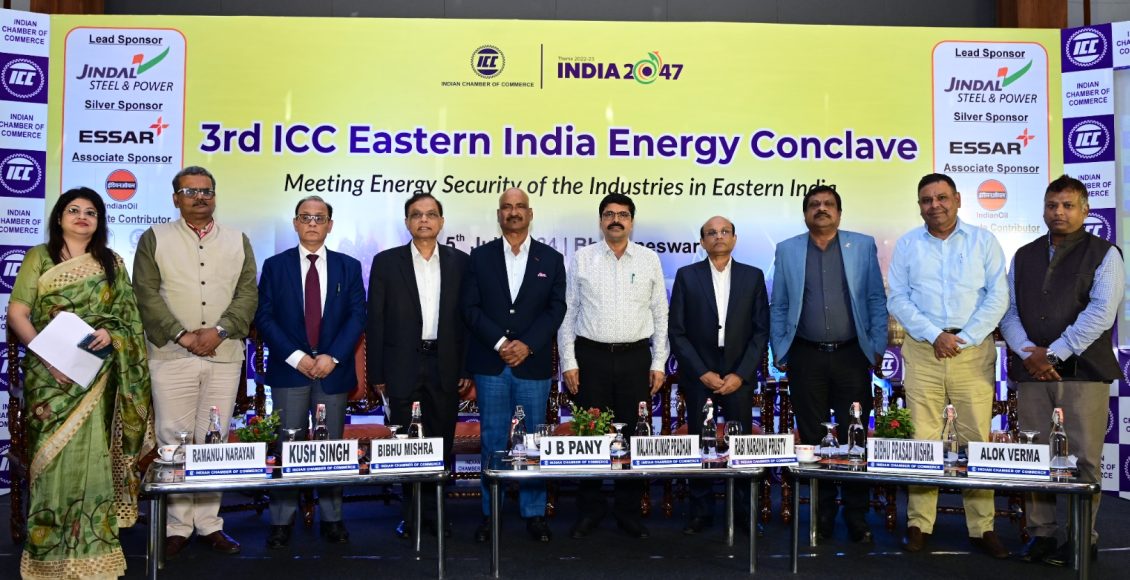Indian Chamber of Commerce held the 3rd edition of Eastern India Energy Conclave in Bhubaneshwar
Bhubaneswar: The“3rd Eastern India Energy Conclave”was organized by the Indian Chamber of Commerce (ICC) on 5th July, 2024 at Bhubaneshwar to create a platform for industries to deliberate and explore the use of alternative sources of energy in Eastern India. ICC Odisha State Council Chairman J B Pany in his welcome address said that energy security plays an important role for industrial growth, economic development and overall prosperity of our country. Peak demand of 250 GW this year is estimated to reach 384 GW by 2031-32. To support this projected demand, India will need an installed capacity of 900 GW by 2031-32. That would require the ultimate goal of achieving 500 GW of installed renewable energy capacity by 2030. East Indian industries, with their diverse and dynamic nature, are at the forefront of this transformation However, the rate and scope of industrial growth in India will determine energy demand in the coming decades compared to other countries Dr. Malay Kumar Pradhan, Deputy Director, Directorate of Factories and Boiler, joined as guest, said that coal is being used as the main source of energy in various factories and broiler plants. Due to which the level of pollution increases and the health risk is created. So in the present situation when we are thinking about developed India, at the same time we need to increase the energy while we need to achieve net zero pollution. Thirteen million people worldwide are exposed to health hazards. According to the report of the World Health Organization, 99% of the people of the world are suffering from it. Of that, $8 trillion is spent on health hazard remediation. Everyone needs to focus on solving this problem. Rabi Narayan Prusty, Chief Environmental Engineer, State Pollution Control Board, said that electric generation is playing a key role in the energy sector. Coal burning is essential. This will increase the amount of air pollution and fly ash production. Therefore, to keep this air pollution within limits and manage the fly ash, it is necessary to consider how to relocate according to the rules of fly ash notification. More attention should be paid to the pollution of places where water, coal and land are available. Although coal is available in few limited districts of Odisha. There is a risk of contamination in the area. While there are many regulations of the government regarding pollution and waste management of power plants, he requested to pay special attention to the regulations coming in the coming days.Keeping in view India’s declared objective to attain net zero emissions by 2070 the industry, particularly the electricity generating industry will have to diversify the energy mix suitably to ensure sustainability and a shift towards low carbon and renewable energy sources such as the maximum possible use of Solar Power, Wind Power, Hydro Power and Green Hydrogen, along with carbon-free energy sources to attain uninterrupted supply of good quality power at an affordable rate. Keeping in view this objective, there has to be a viable replacement for coal based base load power. Nuclear Energy is a strong candidate for a carbon free base load power, though its generation cannot be altered at will. Nuclear-generated power has a higher energy density compared to solar and nuclear plants have longer lifespan.
India’s journey to become a leading economic power and a developed economy will require a substantial escalation in Energy consumption replacing fossil fuel, electricity and transport fuel. India’s energy requirement has to cater to the needs of transportation and basic energy intensive industries like steel and cement, which will see a manifold increase in the coming decades.
Energy needs cover domestic, industrial and commercial energy/ electricity requirements along with the rapidly increasing energy requirement for transportation and vehicle ownership. Sectors such as transport and industry are projected to see significant increases in energy demands, with the transport sector potentially requiring 300 million tonnes of oil equivalent, and the steel and cement industries expected to grow eightfold and threefold, respectively. Climate change and global warming, coupled with multi-storied housing and commercial buildings will require increasing amounts of electricity for cooling, lighting, escalators and electronic gadgetry in finance, banking, IT and other requirements.
Fossil fuel use will have to phased out at the earliest. This will have to be planned along with estimation of the cut-off date for attaining peak emissions. So far, India’s achievements in respect of per capita emissions and also its commitments in respect of adding non fossil fuel sources of energy have been commendable. However, going forward, meeting its emission commitments and the galloping energy needs in tandem with its economic growth, aspirational living, rapid transport and other concomitant needs for energy seem to present a future energy canvas which is likely to be heavily dependent on nuclear power as a base load power. Small and modular nuclear reactors as well as nuclear powered long distance water transport seem to be inevitable. The present locations of coal based power plants could be ideal candidates for installation of SMRs. Power intense industries having extra-large energy requirement and having a large land provision could co-locate nuclear power generation and end use energy intensive industry at the same location. The recent decision of the Government of India to launch an ambitious fleet mode development of nuclear power plants is a welcome step and will need to be accelerated with assured funding in the years to come. Coal based electric power generation industry will have to transit to a judicious combination of renewable energy and nuclear energy to meet future electricity requirements of a developed economy meeting its net zero commitments. There is a logical case for promoting and financing futuristic energy growth areas like Fusion technology in Nuclear Energy to meet the imperatives of clean future growth. The Energy Conclave was addressed by eminent speakers from Industry and Government of Odisha, Dr Malaya Kumar Pradhan
Deputy Director, Directorate of Factories & Boilers, Government of Odisha, Er. Rabi Narayan Prusty, Chief Environmental Engineer, State Pollution Control Board (OSPCB), Government of Odisha, Mr J.B. Pany, Chairman, ICC Odisha State Council, Mr Bibhu Mishra, Advisor, Hindalco Industries Limited, Mr Kush Singh, CEO, Essar Power.

